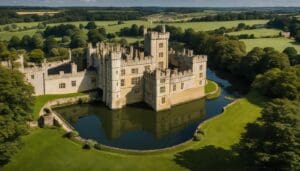Florence, Italy: The City of Wealth, Beauty, and History

Updated On: April 22, 2024 by Dina Essawy
One of the most visited cities in Italy, Florence is famous for its history as it was once a centre of medieval European trade and finance and one of the wealthiest cities at the time. It is also considered the birthplace of the Renaissance movement, and has been called “the Athens of the Middle Ages”.
Florence was the capital of Italy from 1865 to 1871. UNESCO declared the Historic Centre of Florence a World Heritage Site in 1982. The city is well-known for its rich culture, enthralling Renaissance art, captivating architecture and interesting monuments. Forbes has ranked it as one of the most beautiful cities in the world as well.
Florence is also world-renowned for being the centre of Italian fashion and is ranked in the top 15 fashion capitals of the world.
It’s no surprise that the city receives millions of tourists every year, looking to explore the landmarks that made Florence what it is today.
Who are the Medici?
But who was behind it all? Who managed to develop the city so much that it became world-renowned for its art, history and trade?
The answer lies with one family in particular: The Medici.
The real-life family, that inspired the recent hit show Medici: Masters of Florence, was such a powerful and rich family that they practically changed the face of Europe.
They were a powerful Italian banking and political family with overwhelming influence under Cosimo de’ Medici in the Republic of Florence during the early 15th century. The Medici Bank was the largest in Europe at the time, and it facilitated their rise to political power in Florence. Their influence was so great that from among their ranks came some of the most powerful people in Italian history, including four Popes of the Catholic Church and two queens of France (Catherine de’ Medici and Marie de’ Medici).
With their great political influence, grew their interest and influence in the arts, which led to the flourishing of the arts in Florence and they are even said to have had a hand in inspiring the Italian Renaissance.
They are known to have financed the invention of the piano and opera and were patrons of Leonardo da Vinci, Michelangelo, Machiavelli and Galileo.
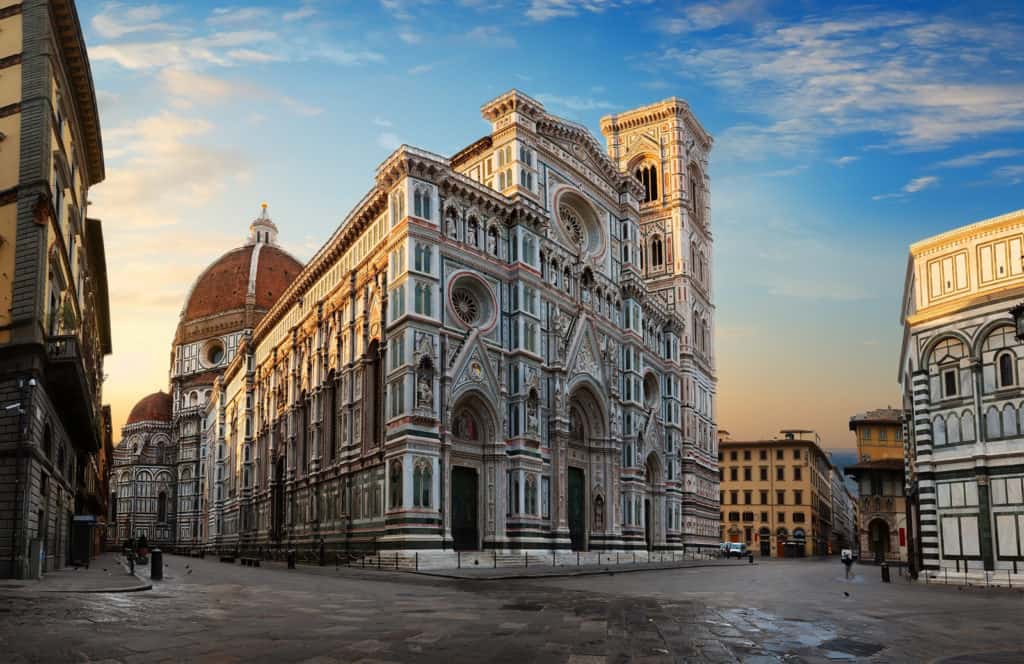
Medici: Masters of Florence (the TV Show)
The first season of the show that is inspired by their life, which aired in 2016, takes place in 1429, the year Giovanni de’ Medici (Dustin Hoffman), head of the family, died. He was succeeded by his son Cosimo de Medici (Richard Madden) succeeds him as head of the family bank, the richest bank in Europe at that time, and fought to preserve his power in Florence. The second season (Medici: The Magnificent), takes place 20 years later recounting the story of Cosimo’s grandson Lorenzo de Medici (known as Lorenzo the Magnificent). A third and final season titled again Medici: The Magnificent completes the story of Lorenzo (Stuart Martin) as he fights to maintain his family’s hold over Florence.
The show has become such a phenomenon that there are now customized tours that can take visitors to the filming locations of the show in Florence as well as the actual homes and palaces of the Medici that are still standing today.
If you’ve watched the show, you may recognize some of the locations we’re about to mention, and if you haven’t, then this is a great chance to start planning your itinerary!
Explore Florence in a Day
If you plan on visiting Florence and have a limited amount of time, we’ve put together this list of the must-see landmarks in the city to help you explore it in one day!
Starting off at the train station, which is the most-used method of transportation to arrive at the city, Firenze Santa Maria Novella railway station lies in the heart of the city and is a stone’s throw away from many well-known landmarks. If you also fancy a meal right away, you can find a Macdonald’s right across the way from the station.
Put on your most comfy walking shoes and let’s get started!
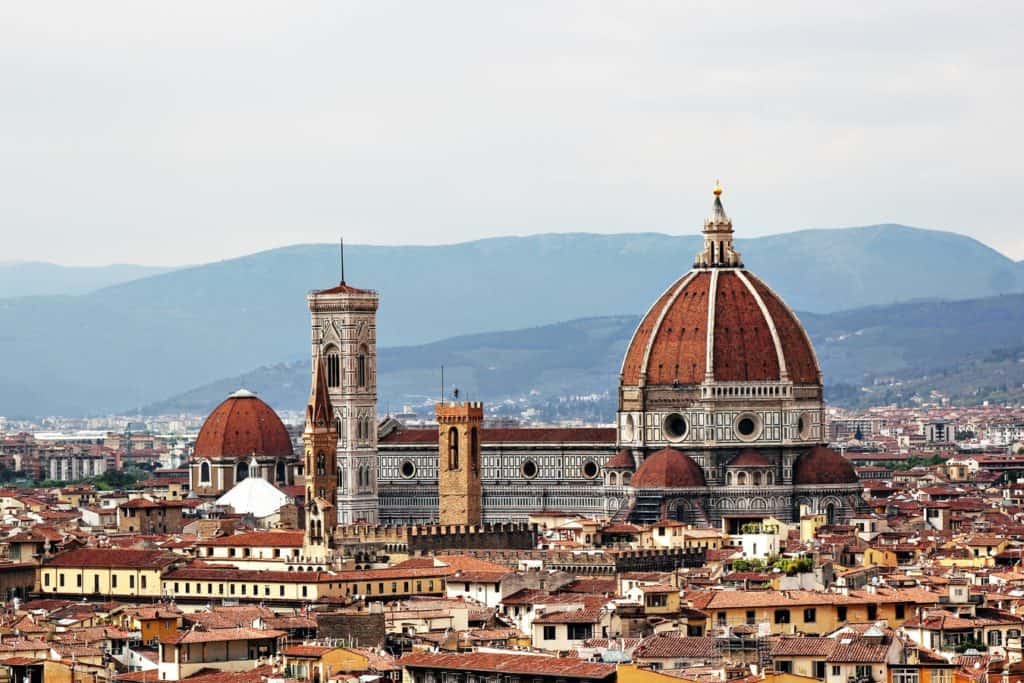
Basilica di San Lorenzo
Walk straight from the station, down Via del Giglio, then take a right and continue straight until you reach Piazza della Stazione to see one of the most important landmarks in the city. It’s a short 4-minute walk from the station to Basilica di San Lorenzo, one of the largest and oldest churches of Florence, and the burial place of all the principal members of the Medici family. It was also mainly the parish church of the Medici family.
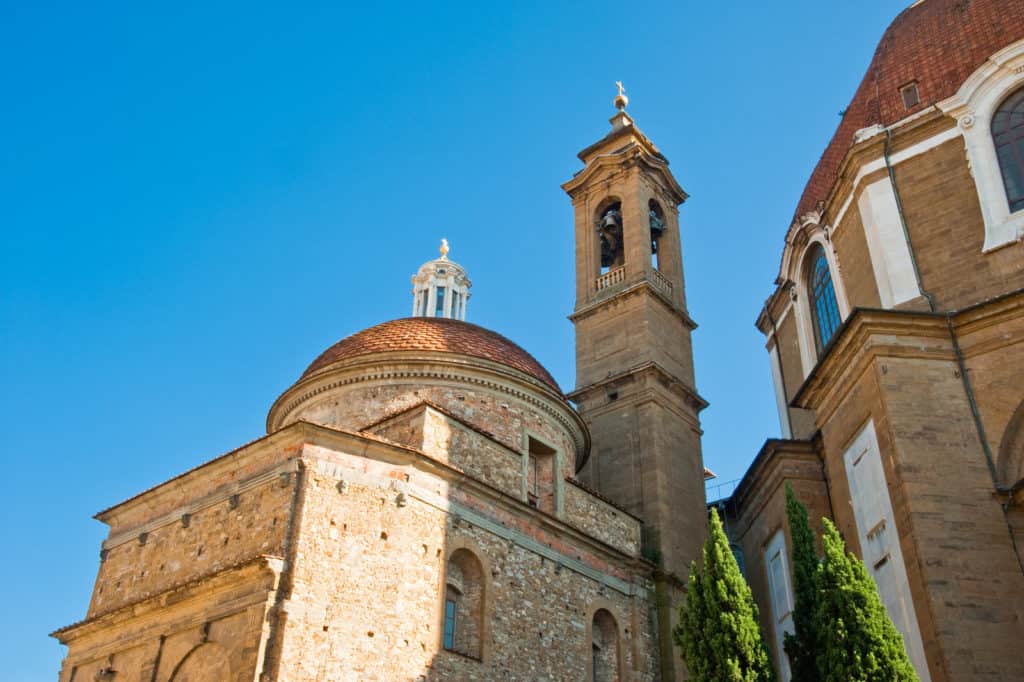
The Basilica of San Lorenzo was built on a church consecrated by the Bishop of Milan, Saint Ambrogio. The present building, commissioned by the Medicis was begun in 1419. In 1442, Brunelleschi was appointed to the project and was responsible for completing the Basilica.
The interior is divided into a nave and two aisles and is considered to be one of the masterpieces of the Florentine Renaissance.
The church is part of a larger monastic complex that contains other important architectural and artistic works, such as the Laurentian Library by Michelangelo; and the Medici Chapels by Matteo Nigetti.
You can visit Basilica di San Lorenzo every day from 10:00 am to 5:00 pm.
Capelle Medici
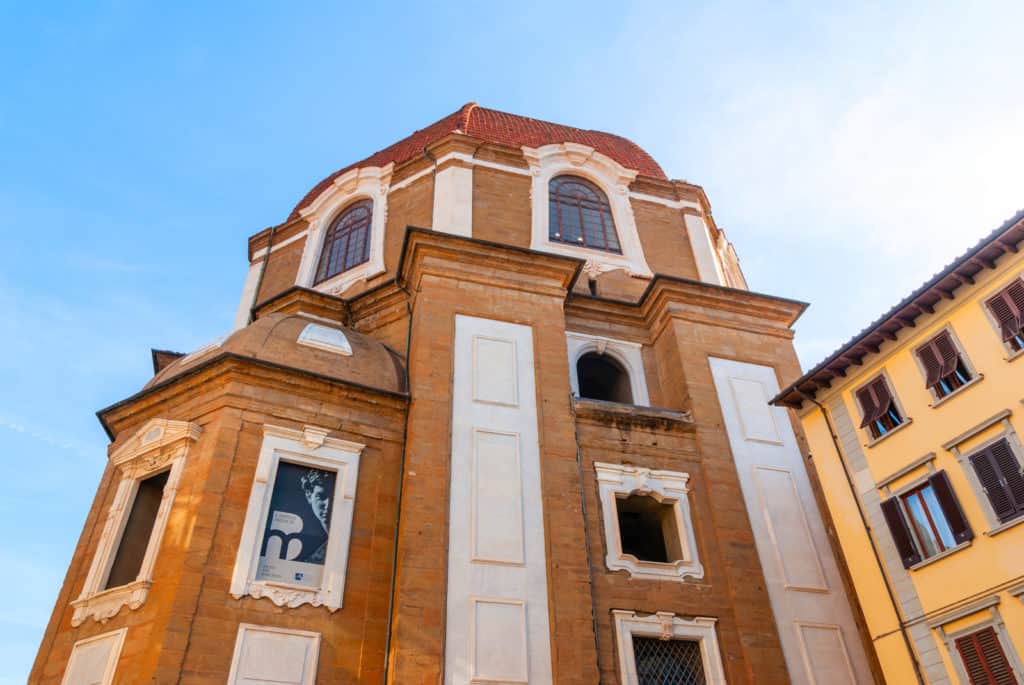
The most celebrated and grandest parts of the Basilica di San Lorenzo are the Cappelle Medicee (Medici Chapels, where almost fifty lesser members of the family are buried. Dating from the 16th and 17th centuries, the Medici Chapels are located at the Basilica of San Lorenzo, commemorating the Medici family, patrons of the church and Grand Dukes of Tuscany. The Chapel of the Princes has a beautiful dome designed by Buontalenti that was begun in 1604 but not completed until the 20th century. The Sagrestia Nuova (“New Sacristy”), as it was also called, was designed by Michelangelo.
The marble lantern at the top of the Medici Chapel with the orb and cross on top are traditional symbols of Roman and Christian power, and here they particularly symbolize the Medici family’s own personal power.
The Medici Chapel is open every day from 8:15 am to 1:20 pm.
Palazzo Medici Riccardi
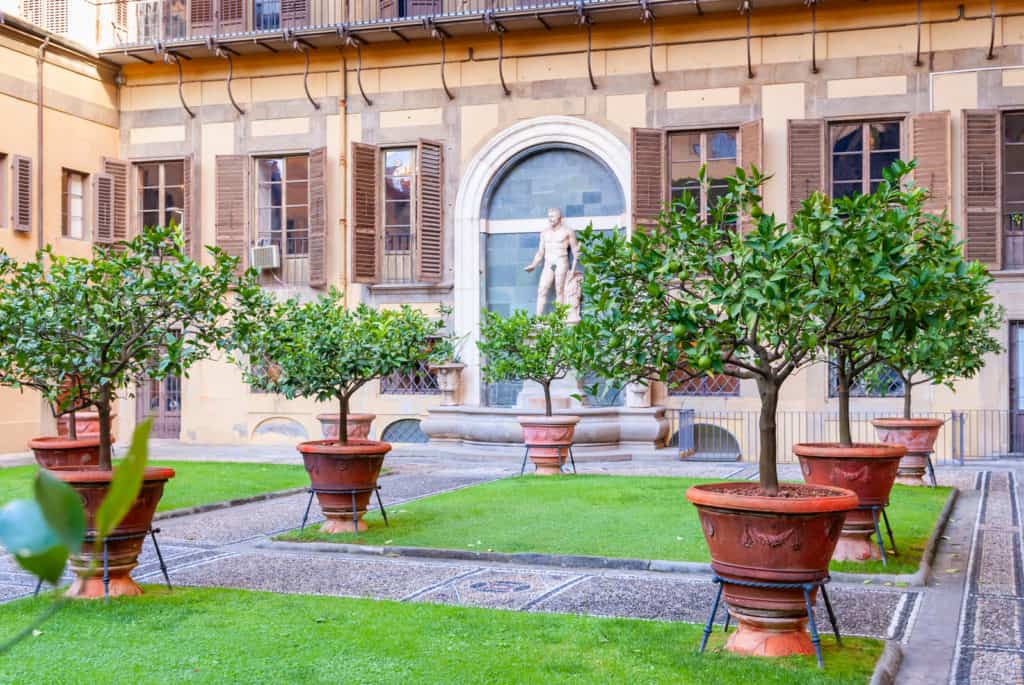
Just round the corner from the Medici Chapel, you’ll find the Palazzo Medici Riccardi, one of the most important landmarks left behind by the Medici family for its close ties with some of its most well-known members.
Palazzo Medici Riccardi was the home of Cosimo the Elder and Lorenzo the Magnificent. It was also the workplace of renowned artists, such as Donatello, Michelangelo, Paolo Uccello, Benozzo Gozzoli and Botticelli.
The Palace was commissioned by Cosimo the Elder in 1444 to the architect Michelozzo and it became the residence of the Medici family and a prime example of Renaissance architecture. In 1494, things took a different turn as the palace was taken over by the new government. The Medici were driven out of Florence and the artworks they possessed were transferred to the Palazzo della Signoria.
Upon their return to the city in 1512, the Medici once again resided in the palace until 1540, when the young Duke Cosimo I dei Medici decided to move their official residence to Palazzo della Signoria.
In 1659, Palazzo Medici was sold to Marquis Gabriello Riccardi and he proceeded to expand the residence and renovate it in the Baroque style until the expenses became too much for the Riccardi family to handle and they ended up selling it to the State in 1814, who in turn used it as administrative offices until 1874.
Architecture
The facade of the palace is described as austere, which seems to have been the preference of Cosimo de Medici. However, despite its apparent lack of grandeur, the palace became an architectural model for newer palaces in Florence.
The statues that once adorned the palace garden are now situated at the Uffizi and the Palazzo Pitti. Today, it contains potted lemon trees and a small fountain. You’ll also find a statue of Hercules.
Opposite the austere exterior, the interior of the palace is quite lavish.
On the first floor of the palace, you’ll come across the Chapel of the Magi with its beautiful gilded ceiling designed frescoed by Benozzo Gozzoli in the 15th century. It was used as the private chapel for the Medici family, but visitors were also allowed inside.
The staircase leads to the Room of the Four Seasons, a council room decked with a Florentine tapestry depicting the different seasons. Next is the Sala Sonnino with walls covered in ancient bas reliefs depicting the mythical hero Hercules. However, the most famous item in the room is the painting of the Madonna and Child by Filippo Lippi dating back to 1466.
Afterwards, comes the Galleria di Luca Giordano, built in the 1770s for Gabriello Riccardi and decorated in the Baroque style with a magnificent ceiling fresco painted by Luca Giordano. The fresco depicts the ‘Apotheosis of the Medici dynasty’.
On the ground floor, you’ll find several exhibition rooms with a collection of Roman sculptures acquired by Riccardo Riccardi.
Duomo (The Cathedral of Santa Maria del Fiore)
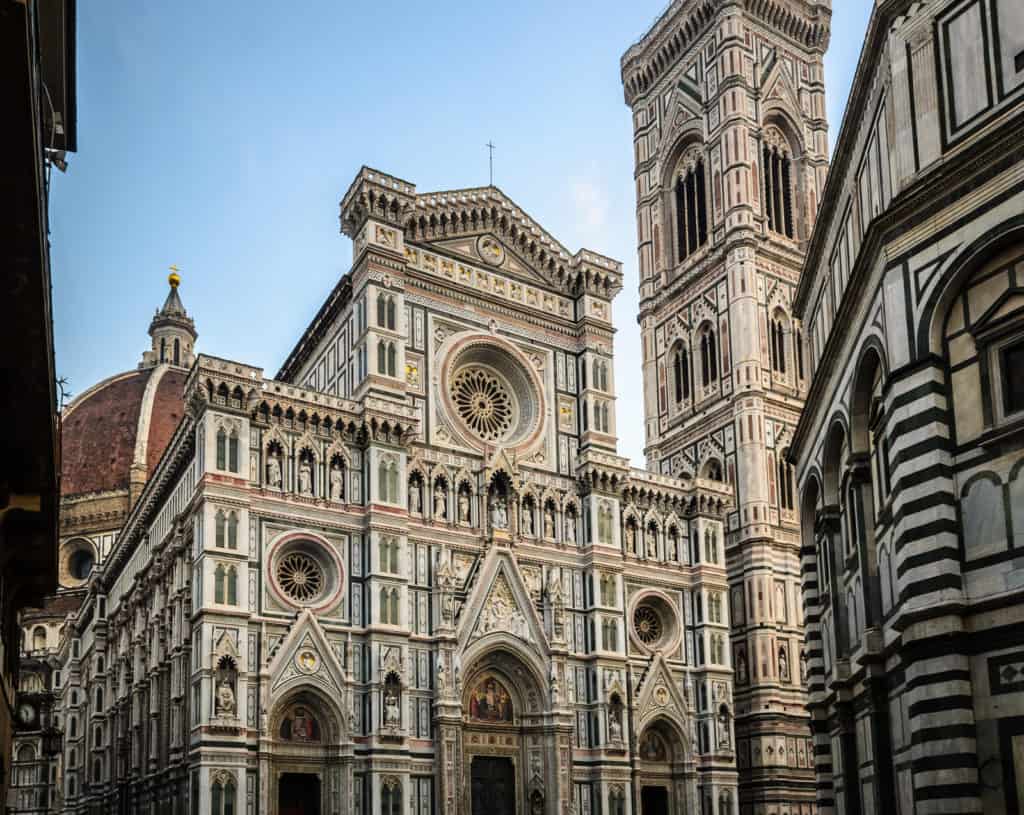
Designed by Filippo Brunelleschi, the cathedral is one of the 10 biggest churches in the world to this day while its dome remains to be the largest brick dome ever constructed. The Duomo was named after Santa Maria del Fiore. It is a gigantic Gothic structure built on the site of the 7th-century church of Santa Reparata. The cathedral actually took around 140 to build as it was originally begun at the end of the 13th century by Arnolfo di Cambio, but the dome was added in the 15th century based on a design by Filippo Brunelleschi. To honour these brilliant minds, a statue of each was erected to the right of the cathedral.
Inside, you’ll notice a clock above the entrance, which was designed in 1443 by Paolo Uccello and surprisingly it still works to this day. The largest and most impressive artwork decorating the interior of the cathedral is Giorgio Vasari’s frescoes of the Last Judgment.
The cathedral’s dome was built between 1418 and 1434 to a design which Filippo Brunelleschi entered in a competition in 1418 but which was only accepted, after much controversy, in 1420. The famous bronze doors of the cathedral are known as The Gates of Paradise.
The Duomo di Firenze is open from 10:00 am to 4:30 pm. Entrance is free.
Ponte Vecchio
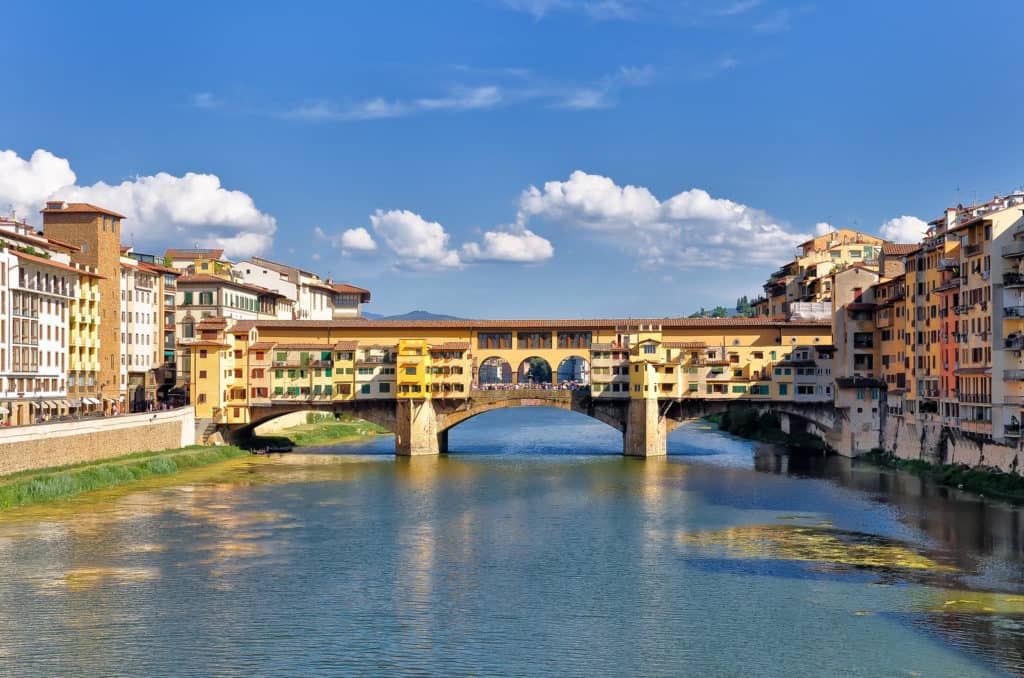
Located to the south of Piazza della Repubblica, Ponte Vecchio (Old Bridge) existed in Roman times as a passageway along the Via Cassia. After being destroyed and rebuilt a number of times due to flooding, Ponte Vecchio as we know it today was reconstructed on three arches in 1345 probably by Neri di Fioravante. The tiny shops of gold merchants (in the middle ages there were fishmongers, butchers and leather shops) and the small houses on the sides of the bridge are its most characteristic features.
The bridge was originally built for the purpose of defence; however, the windows we can see now all across the bridge were added after the shops were sold to the merchants.
When the Medici moved their residence from Palazzo Vecchio to Palazzo Pitti, they decided they needed a connecting route in order to keep out of contact with the people they ruled. To do that, they had the Corridoio Vasariano built in 1565 by Giorgio Vasari and it now runs above the goldsmiths’ shops on the Ponte Vecchio.
You cannot cross the Ponte Vecchio without noticing the Vasari Corridor; another wonder of the Renaissance period. This covered passageway, named after its architect Giorgio Vasari, runs above the shops. The corridor was commissioned by Cosimo I de’ Medici in order to embellish the area surrounding the Palace of the Signoria, and also to connect the Uffizi with the Pitti Palace, his residence across the river.
Some of the shops on Ponte Vecchio have been there since the 13th century. The area used to include shops for butchers, fishmongers, and tanners, but in 1593, Ferdinand I decreed that only goldsmiths and jewellers be allowed to have their shops on the bridge.
Interestingly, Ponte Vecchio is the only bridge in Florence that survived World War II.
The view from the bridge is quite stunning and if you want an interesting view of the bridge itself, you can take a boat ride in the river during sunset for an amazing excursion along of the most interesting attractions in the city.
Piazza delle Repubblica and Fontana del Porcellino
On your way to Ponte Vecchio, you may come across the Piazza delle Repubblica with the Fontana del Porcelino.
Piazza della Repubblica is one of the main squares in Florence in the centre of the city. The Colonna della Dovizia (Column of Abundance) marks the point where the Roman forum stood. It dates back to 1431.
As the city centre, during medieval times, the area around the column was densely populated with markets and churches.
In the 18th century, sadly some of the medieval towers, churches, workshops, homes and original seats of some of the Guilds were destroyed in order to achieve a more modern urban look.
If you dally along the square, you might be lucky enough to catch one of the impromptu street shows. You can also have a hot drink at the Caffé Gilli, Caffé Paskowski and Caffé delle Giubbe Rosse which were meeting points for many of the city’s artists and writers in the past.
Another well-known feature overlooking the square is the Hotel Savoy. Another modern facet added to the area is the Hard Rock Cafe, where concerts and parties are frequently held.
Another interesting monument near the Ponte Vecchio is the Porcellino Fountain beside the arches of the Mercato Nuovo. The site became very popular due to the legend that touching the nose of the Porcellino is lucky. You may also put a coin in the pig’s mouth after rubbing the nose – if the coin falls into the grates where the water hits it will bring you luck, if not it won’t.
The fountain originally helped supply water to the merchants who traded in the market, who mainly sold fine fabrics such as silk, brocades and woollen cloths.
The area is usually very crowded in the Piazza del Mercato Nuovo, where a traditional market is held every day where you can find bags, belts and souvenirs.
Piazzale Michelangelo (view of the city) – 9:30 am to 1:00 pm and then from 3:00 pm to 7:00 pm
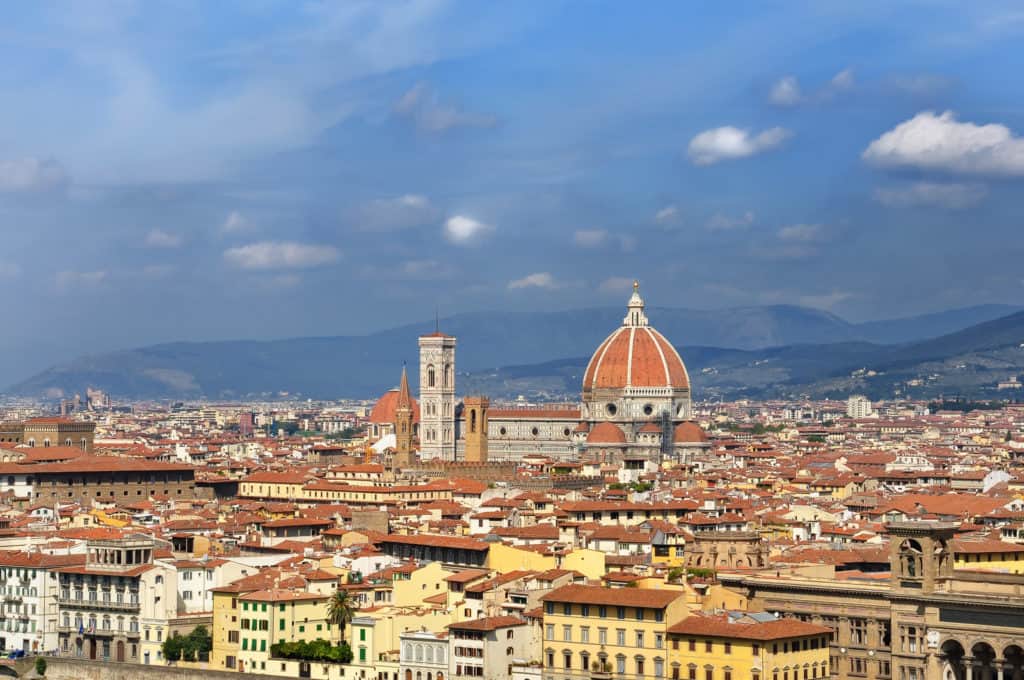
Now, for a magical opportunity to view all of Florence from above, you cannot miss the chance of climbing the steps to Piazzale Michelangelo.
Many mistakenly believe that this piazza was designed by Michelangelo himself. Actually, it was created in 1869 by Florentine architect Giuseppe Poggi, as part of a major restructuring of the city walls.
The vast terrace is typical of 19th-century designs and showcases copies of Michelangelo’s masterpieces. Poggi designed a monument base dedicated to Michelangelo, where copies of Michelangelo’s works, including the David and the Medici Chapel sculptures from San Lorenzo, were displayed. Poggi also designed the building as a museum for Michelangelo’s works. However, the project never came to fruition and now houses the restaurant La Loggia, featuring a coffee bar (from 10 am-midnight) and a restaurant with a panoramic terrace (12 pm -11 pm).
In 2016, the piazza was restructured to highlight the stunning beauty of the city and give guests an opportunity to enjoy peaceful views above the Italian city of Florence.
You can walk up to the Piazzale Michelangelo from downtown Florence or you can also take the bus (bus 12 or 13 from the centre or the sightseeing tour bus) or drive up there if you have a car.
After finishing your tour of the piazza, consider taking a five-minute stroll up past the church of San Salvatore to the monastery of San Miniato al Monte, which has the best view of the city, and is a stunning example of Tuscan Romanesque architecture dating back to 1013.
Then, take a panoramic walk from San Miniato back to the city centre by going down onto Viale Galileo to enjoy the tree-lined promenade with some of the most magnificent panoramic views of the city of Florence until you reach Via di San Leonardo. During your walk, look for the plaque on the wall of the first villa on your left that says Tchaikovsky lived here in 1878.
Gardino Bardini (8:15 am to 4:30 pm)
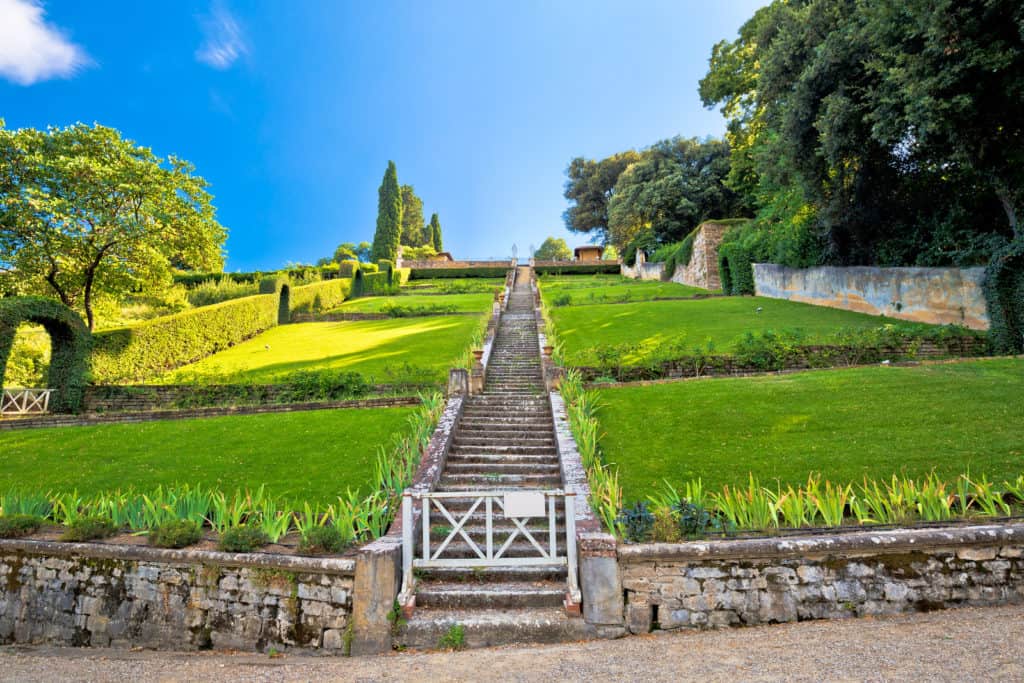
The Giardino Bardini (Bardini Garden) is one of the well-known attractions in Florence. The Bardini Garden offers a remarkable panorama over Florence that occupies a large part of a hill bordered by the medieval walls of the city.
Dating back to medieval times, the Bardini Garden belonged to a series of wealthy families. Originally constructed for agricultural purposes, it was transformed over the course of the centuries into a splendid garden. At the beginning of the 1900s, it was used by Stefano Bardini (known as the “prince of the antiquarians”) as an impressive setting to entertain his affluent clientele.
The Bardini Garden is comprised of three styles of gardens representing different eras:
The Italianate Garden, with the magnificent baroque staircase;
The English Garden represents a rare example of Anglo-Chinese landscaping;
The Agricultural Park is where an orchard and the iconic wisteria pergola are located.
Tickets to enter the garden are € 10,00 or € 2,00 for persons between the ages of 18 and 25 who are members of the European Community and for teachers with permanent state school contracts.
Free Entry: for everyone on the first Sunday of every month.
Piazza della Signoria
The Piazza della Signoria is located directly in front of the Palazzo Vecchio and it was named after the Palazzo della Signoria.
The Piazza della Signoria contains many impressive landmarks including the impressive 14th-century Palazzo Vecchio and the Loggia della Signoria, the Uffizi Gallery, the Palace of the Tribunale della Mercanzia (1359), and the Palazzo Uguccioni (1550).
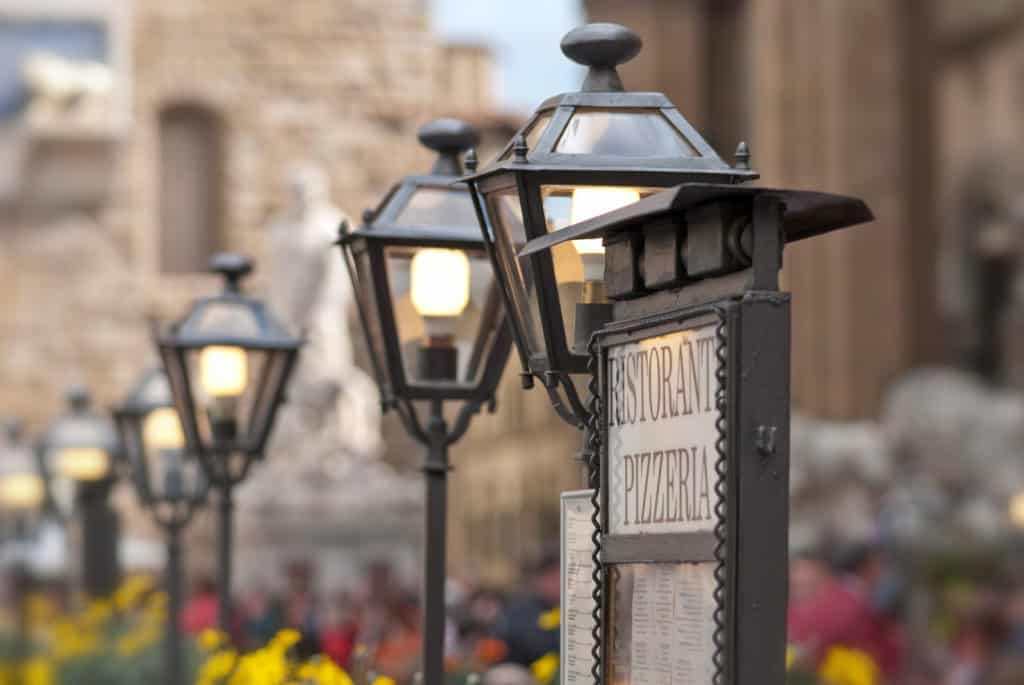
More to See in Florence
If you have a bit more time, or if you’re staying for a couple of days or more in the city, then we recommend visiting the following sites to get to know the true essence of Florence.
There are now many tours being offered to the fans of the show Medici: Masters of Florence, where you can trace the steps of the actors and visit the main filming locations where it was filmed around the city.
These tours start from Piazza Signoria where each statue of the square hides a deeper meaning related to members of the Medici family. Then, you will move on to the Palazzo Vecchio’s courtyard to appreciate the Tower of Arnolfo where Cosimo the Elder was imprisoned, followed by a stroll along the Dante Alighieri district to arrive at Piazza del Duomo where you will discover the incredible story of the construction of Brunelleschi’s Dome and the Cathedral. The tour includes entering the Cathedral where you will admire the largest frescoed surface in the world (3,600 square meters).
You can then walk by St John’s Baptistery, where Cosimo de’ Medici used to pray, to learn about the scenes of the Gates of Paradise, a masterpiece by Lorenzo Ghiberti. You will also walk along the ancient Via Larga up to Palazzo Medici the first Renaissance palace in Florence, the private home of the Medici family for nearly two centuries. The tour includes the Magi Chapel, walking through the garden of the palace to discover the Antiquarium and finally, the Church of San Lorenzo in the Medici District with its stunning architecture and where you will see the tomb of Cosimo the Elder. The tours usually end with the Medici Chapels, where all the members of the family were buried, and which house the “Treasure of St. Lorenzo”.
Florence is one of the most beautiful cities in Italy, there’s no doubt about it. That is why so many filmmakers choose it as a backdrop for their films (but that’s a story for another article). While most of the attractions around the city can be visited in one day, we still recommend spending a couple of days in this enchanting city in order to truly enjoy all that it has to offer. From history to art and culture, Florence is truly a magnificent city and while the Medicis are credited with much of its original development, it still managed to maintain its magnificence to this day.



